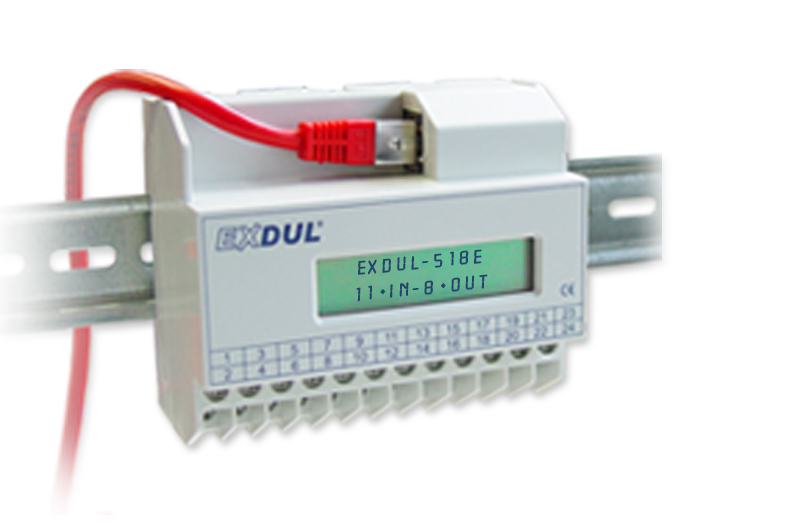Ethernet control module - optocoupler inputs - power outputs

EXDUL-518E
- 11 optocoupler inputs
- 8 optocoupler outputs 1A
- 6 counters
- Programmable logic
- Module initiated message
- watch dog
- web server/webpage
- LCD display
- 100Base-T Ethernet interface
EDP number: A-374540
Digital inputs via optocouplers, outputs via optocouplers and FET power switches
The powerful EXDUL-518E Ethernet control module with RJ45 connection has 11 digital optocoupler inputs and eight digital power outputs with galvanic isolation. The bipolar optocoupler inputs are secured with additional overvoltage protection diodes. The optocoupler outputs, which are protected with reverse polarity protection diodes, can each switch a maximum current of 1 A per channel due to the downstream FET power switches. Contact A of the FET (source, + connection) is connected to one terminal each, contact B (drain, - connection) is brought together on a common terminal for all 8 channels. A freewheeling diode can be switched on for each channel to protect the FET power outputs from voltage peaks in the case of inductive loads.
Inputs can be used as counters
If required, six of the 11 optocoupler inputs can also be programmed as hardware-supported 32-bit counter inputs. The counters can be used up to a maximum input clock of 5 kHz. In order to prevent data loss in the event of a power failure, the meter readings are saved in the module at intervals of 100 µs and automatically loaded into the meter register when the module is restarted.
Webpage
The module can be configured in a user-friendly manner via the integrated web page. A simple function test is also possible.
Communication via TCP/IP connection
The communication between the PC and the module takes place via the sending and receiving of byte arrays via a stable TCP/IP connection, which is protected by a handshake protocol.
Watchdog
The EXDUL module has some security mechanisms for stable communication. However, if communication is interrupted, e.g. due to routing problems, and the connection can no longer be reestablished, the module's integrated watchdog timer can be used to troubleshoot the problem.
Programmable logic
In various applications it can be advantageous if the module reacts independently to input signals or changes at the inputs. Without this option, a change at the input can only be detected by regularly querying the inputs using polling. This polling causes an increased load on the network and the computer. In order to generate this independent reaction of the module, four logic branches are provided, each with four logic inputs, a link and a logic output. This logic output can then be connected to an optocoupler/FET output or used for messages to the PC.
Power supply
The module is supplied with the necessary operating voltage of between 10 and 30 volts via an external voltage source.
LCD-display
The programmable LCD display enables the display of digital I/O status information or programmable user-specific data.
Connection and assembly
The connections for the power supply, like the connections for the input and output optocoupler, are routed to a 24-pin screw terminal strip. The compact housing allows use as a mobile module on the notebook and as a control module in control and mechanical engineering with simple wall mounting or uncomplicated mounting on DIN EN mounting rails.
Software, drivers, programming languages
No driver is required for the EXDUL-518 Ethernet module. A prerequisite is a provided network connection from the PC (network card with driver) or mobile device. The TCP/IP libraries available in many high-level languages such as C, C++, C#, Visual Basic or Java are required for direct access to the module.
Supported operating systems and programming languages
Microsoft Windows®
Java®, VB.net®, C++.net®, C#.net®, Python®, Labview Tutorial®
Linux®
C®, C++®, Java®, Phyton®
Android®
C#®
